The Route of Medieval Churches in the Upper-Tisza Region - Winner 2017
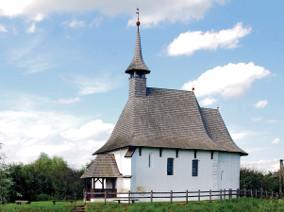
Winner in the Cultural Tourism category
The 'route of medieval churches' raises public awareness. Not only about the churches themselves, but also about other spectacular natural and cultural heritage sites in the Upper-Tisza region. The national tourism development strategy 2030 states: “There are 357 historical monuments in the region, the main attractions are the popular and well-known churches of Kisvárda, Nagyar, Tarpa, Csaroda and Tákos, all parts of the Hungarian section of the thematic route called route of medieval churches”.
What makes the Route of Medieval Churches in the Upper-Tisza region special?
Visiting the route of medieval churches you feel as if you were in a fairy tale. There's a mystic world of past history with ancient moors, lakes, hillforts, churches dating back to the Hungarian Kingdom, wonderful shrines, literary memorial sites and grand castles. As the spirit of the place permeates the local villages, everyone who enters the gate of Fairyfield, falls in love with this marvellous land. The charm of Fairyfield, the symbol of Szabolcs-Szatmár-Bereg County is tangible throughout the landscape, in the medieval churches, in the flavour of fruits grown here, in the silence of nature and in the eyes of the local people.
Cultural tourism
The 'route of medieval churches' is the name of the thematic route designed to familiarise interested tourists with the unique religious and cultural heritage in the Carpathian Basin. This thematic route was created to present the medieval ecclesiastical heritage of 3 geographical units. These units comprised a historical region in the past: Northeast Hungary, Kárpátalja (Subcarpathia) and the northern area of the region called Partium.
The medieval churches in Kárpátalja (Subcarpathia) represent the eastern frontier of Western Christianity. In this region, Gothic architecture meets the wooden church characteristics of the Greek Orthodox denomination. Many of them were destroyed during the Mongol Invasion of Europe. The remaining ones were seized one after another by the Calvinists as the Reformation gained ground. A large number of churches burned down during the freedom fights of Early modern history. In Soviet times, churches were often transformed into museums for atheists. Now that there is peace in the region, churches became tourists' attractions.
The Upper-Tisza region is one of the few places in Hungary where the cultural heritage of nature and history remained so authentic.
At the moment, the route of medieval churches involves 65 medieval churches but the number of medieval churches (or churches of medieval origin) is over 100.
Sightseeing tips
There are many cultural attractions, including medieval churches, wooden bell towers, ruins, mills, castles, memorial houses and museums. Some noteworthy sites are
- wooden bell-towers in the Upper Tisza-Region, on the UNESCO World Heritage Tentative List
- the decorative boarded ceilings, the painted galleries and the carved, richly decorated pulpits of Medieval Churches of Tákos and Csaroda
- bicycle heritage tours on the Route of Medieval Churches
More information
- Route of Medieval Churches website (in English)
- EDEN video about Route of Medieval Churches
- EDEN contact for Route of Medieval Churches: info
 szszbmfu [dot] hu (info[at]szszbmfu[dot]hu)
szszbmfu [dot] hu (info[at]szszbmfu[dot]hu)
Mecsek Greenway - Winner 2015
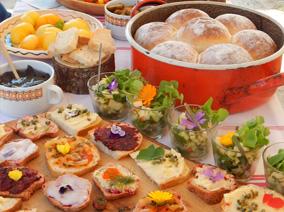
Winner in the Tourism and Local Gastronomy category
Mecsek Greenway is a live and functional workshop that helps locals and visitors in their mental and physical recreation. Locals have created this horizontally organized, strong network of equal men and women drawing on their own inner resources to build this very special community.
The participating members of Mecsek Greenway are confident that the revitalisation of local communities, the development of connections between villages, plus research and transfer of local values can serve as a basis for sustainable rural development and tourism.
What makes Mecsek Greenway special?
In Mecsek, visitors are welcome anytime just to be around and experience harmony with nature. Perhaps you would like to retreat into a safe forest dwelling where somebody takes you a fine dinner every evening or where you can pick what you like from a bag filled with local products? Beautiful village guest houses and lakeside resorts are at your disposal, whether you come with children, friends or colleagues.
In case you want a little more than just taking it nice and slow, you can take part in the culinary preparations by kneading the dough, baking your own bread, chopping wood or stoking the stove. Collect your own herbs or mushrooms, prepare medicinal foods with cooks of great knowledge, decorate your sandwich with edible flowers, cook jam in a cauldron and discover all sorts of natural and culturalwonders.
Taste wild flowers, wild garlic, holly, Jerusalem artichokes, blackthorn, hawthorn, weed soup, farm hens, ducks, pork, venison and fish. Here you can have almost anything your eyes, heart and belly desires.
Outdoor activities like rock-climbing, hiking, paddling, swimming, boating, hiking or biking are also available.
Local gastronomy
Flavours come alive in Mecsek!
Mecsek's natural attractions are wonderful and include beautiful historic monuments, cultural and ethnographic heritage, good accommodations, a diversified gastronomy based on and upholding Hungarian, German, Slovak and Gypsy traditions.
Mecsek is a region where the buffet lunch includes seasonal local products like edible flowers, forest weed and mushrooms. It is the place where the pig that yielded the meat for the roast was slaughtered just yesterday, and where the artichokes have been unearthed this very day. Here, the food contains no preservatives, dried fruit is desiccated in the sun, the tomato is not treated with pesticides.
Visitors can also gather ingredients in the forest and experiment in the kitchen themselves. Special dietary needs of visitors are of course taken into account.
Members of the Mecsek Greenway have meticulously identified the local values, products, services, events, traditions and gastronomy of individual villages. They are committed to popularising traditional, seasonal local products that are made without chemicals and preservatives and are committed to gathering and using plants and mushrooms of the forests and meadows in an environmentally friendly way. Members are devoted to sharing this knowledge, to raising awareness of medical foods and healthy eating, and to promoting a tourism that supports local communities in a sustainable, gentle, green, and ecological way.
Developments in the region are not festival-driven: Mecsek Greenway members plan events that are quiet, only attract few tourists at a time, are environmentally friendly, sustainable and available in all seasons and at all times.
Sightseeing tips
- See the UNESCO World Heritage site of Pecs, where the Celts erected earthworks on the Jakab Mountain and the Roman Empire bequeathed villas, roads and tomb chapels in the village.
- Take a walk on the tourist paths created in the Mecsek Mountains, and learn about the special flora and fauna of the region along educational trails.
- Visit one of Orfu's three famous festivals: Wild Garlic is held in spring, Fishing on Orfu in the summer and Pumpkin Festival in the autumn.
More information
- The official website of Mecsek Greenway
- EDEN video about Mecsek Greenway
- EDEN contact for Mecsek Greenway: bia [dot] cserkut
 gmail [dot] com (bia[dot]cserkut[at]gmail[dot]com)
gmail [dot] com (bia[dot]cserkut[at]gmail[dot]com)
Kaposvar and Zselic - Winner 2013
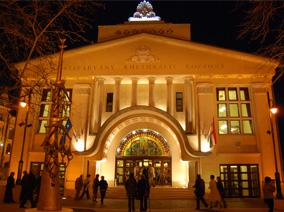
Winner in the Accessible Tourism category
Culture is embraced in the Zselic district, and adventure awaits you at every turn!
Come and visit Kaposvar and the surrounding area. Experience the unique atmosphere and the wide range of programmes the destination offers tourists.
The town centre was developed at the turn of the 20th century and the fashionable facades of that era have been preserved in all their original splendour.
Wandering around the city centre of Kaposvar, built in the Art Nouveau and Eclectic Style, visitors bump into statues and buildings with their stories waiting to be told at every turn. Explore the stories and learn about the fascinating history of the city and of its people.
The neighbouring forests, lakes and villages offer excellent opportunities for nature walking, hiking, fishing and learning about local architectural traditions. An adventure park for children is also available.
Accessibility
The Municipality of Kaposvar and its partners aim to provide accessible services for tourists and locals alike.
A significant part of Kaposvar’s city centre is a pedestrian only area, which has reduced air pollution and eliminated traffic. It also allows the centre to serve as a venue for a variety of cultural and community events. Recent years have seen a continuous increase in the number of bicycle lanes and paths.
Adapted pedestrian crossings, ramps, tactile signals, orientation, barrier-free zones for wheelchair users at festivals and a well-adapted public transport system are just some of the assets of accessible Kaposvar.
Sightseeing tips:
- Admire the Csiky Gergely Theatre, one of the jewels of Art Nouveau.
- Pet a deer at the Boszenfa Deer Farm!
- Join the unique stargazing tours at the Zselic Dark Sky Park, one of the three dark sky parks of Europe.
- Go back to the past at the Medieval Festival of Knights where visitors touch, try on and experience real medieval shells, arms, habits and traditional dresses, craft activities and dances.
More information:
- The official website of Kaposvar
- See the EDEN video about Kaposvar and Zselic:
- EDEN contact for Cavan: turisztika
 kaposvar [dot] hu (turisztika[at]kaposvar[dot]hu)
kaposvar [dot] hu (turisztika[at]kaposvar[dot]hu)
Mecsek - Winner 2011
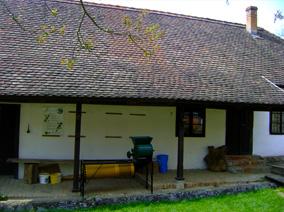
Winner in the Tourism and Regeneration of Physical Sites category
The Mecsek region is situated in the southern part of Hungary.
Its defining features are a green landscapes, vineyards and Mediterranean climate. Fig, almond and chestnut trees are very common here due to mild temperatures.
There are several cities and towns to explore in the region, such as Pecs, a Roman city, with buildings that date back to the second century, and Villany, a small town best known for its wines.
The Mecsek region offers countless possibilities for active, as well as cultured holidaymakers. The region is renowned not only for its beautiful scenery, but also for its historical and cultural heritage. There is something for everyone to explore.
Regeneration and revival
Several projects were initiated to increase the breadth of tourist attractions in the region.
Mecsek’s disused industrial and cultural heritage sites were renovated and given a new purpose.
The Benedictine cloister, a castle in Pecsvarad, famous for its healing qualities, has now been converted into a museum and a hotel.
One of the most prominent transformations that took place in the city of Pecs was the new culture and arts quarter, built around the famous porcelain factory Zsolnay.
Today, the old factory still produces porcelain, but there is also now space for exhibitions and presentations, a visitor centre providing information about cultural events and activities, numerous cafes as well many other amenities.
Over 200,000 visitors come to the Zsolnay Cultural Quarter every year. With different parts of the quarter dedicated to different activities, it has been one of the most impressive success stories in the region.
Another highlight is Orfu, a resort with lakes, forests and beautiful parks. There are significant developments in progress here, such as an aqua park, water-tourism centre, an open courtyard and cycle paths.
There is also a Mill Museum, where millers mill wheat and sell homemade bread.
Sightseeing tips
- The Nador Gallery exhibits the works of contemporary local, international artists. It is situated in an old hotel building in Pecs.
- To see the hidden treasure of Mecsek, take a tour inside the Trio Cave.
- Have an exciting day in the adventure park Mecsextrem.
More information
- The official website of Mecsek
- See the EDEN video about Mecsek:
- Long version (3 minutes)
- Short version (1 minute)
- EDEN contact for Mecsek: gasz [dot] bernadett
 gmail [dot] com (gasz[dot]bernadett[at]gmail[dot]com)
gmail [dot] com (gasz[dot]bernadett[at]gmail[dot]com)
Lake Tisza - Winner 2010
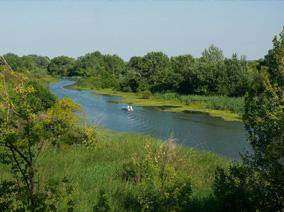
Winner in the Aquatic Tourism category
Hungary’s largest man-made lake, Tisza, was created by damming the river Tisza in 1973 to facilitate flood prevention. The filling of the lake was finished in the 1990s.
Today, it is an extraordinary area of 127 km2. Next to the undisturbed nature, you can find sailboats and windsurfers skimming over the pristine waters of the lake.
The beauty of the region is miraculous. A few kilometers away from the lake you will find Europe’s largest field of blossoming water lilies and fringed water lilies, the uninterrupted carpet of water chestnuts and the many willow trees bowing on the banks.
The possibilities for a great holiday at Lake Tisza are countless. Several guided tours are offered, which run year-round. Some of the most popular tours include the Sunset/Sunrise Tours, during which the guests will see beautiful sights of the sun from unusual, hidden spots.
The Nature Trail and Water Walkway are two more popular tours to take. They connect three islands and is 1.5km long.
What makes the Lake Tisza special?
Watching the nature is an adventure in itself, which begins right from the time when visitors arrive to the area, and see the lake, hear the singing birds and see the image of villages surrounding Lake Tisza.
It is a truly unforgettable experience. The adjacent villages are unique clusters of folklore, local rituals and traditions, which are reflected everywhere, in architecture, furniture and traditional outfits.
Local craftsmen are keen on sharing their experience with visitors. In the village of Tiszafured, one can learn about the long local tradition of ceramics in one of the pottery houses.
Sightseeing tips
- Visit the Fish Days fair – a 3-day fair where visitors can taste delicious fish specialties, watch folklore dances and presentations, or watch fishermen’s competition.
- Participate in the GPS treasure searching game – a state of the art technique that has been used in the region to specialise the study tours.
More information
- The official website of Lake Tisza
- Watch the EDEN video about Lake Tisza:
- Long version (3 minutes)
- Short version (1 minute)
- EDEN contact for the Lake Tisza : gyorgyi1202
 citromail [dot] hu (gyorgyi1202[at]citromail[dot]hu)
citromail [dot] hu (gyorgyi1202[at]citromail[dot]hu)
Irottko Nature Park - Winner 2009
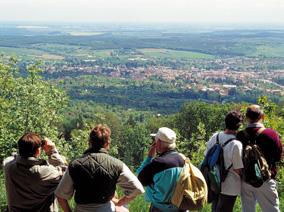
Winner in the Tourism and Protected Areas category
With its many hiking, walking and biking trails, the Irottko Nature Park offers visitors unsurpassed contact with nature.
The Blue Tour, Hungary's most important and oldest hiker's movement, dating back almost 120 years, starts at the top of Irottko Mountain and winds its way through some of the most breath-taking sceneries in the park.
For less extreme alpine lovers, there are many study trails offering shorter hikes through detailed rock formations and flower zones. The Stichwort study trail, which curves its way through some amazing floral areas on Koszeg Mountain, is a popular choice amongst nature lovers.
For those wishing to see the region by bicycle, there is a regional cycling center at Rowling Lake that rents bikes daily.
What makes Irottko Nature Park special?
The sense of inner peace that Irottko inflicts on its visitors is unforgettable.
The Seven Springs, located close to the Austrian border, provide a relaxation experience like no other. The hot springs were named after the seven tribes that founded Hungary in the 9th century. The structure that houses the springs was built in 1896 to mark Hungary's millennium celebration.
A new program called the Wine Route of Koszeg was formed in 2004 to give tourists an understanding of the time and energy dedicated to producing some of the country's unique wines.
Other products such as honey cakes, goat cheese and apple products are produced in the region and are tasty delights loved by visitors. The newly-built Herb and Spice Garden opened its doors in 2005 and it focuses on all-natural products.
With many links to the past, the Irottko Nature Park's secured place in Hungary's rich history is a priority. Eco-friendly practices in agriculture, construction and forestry have been at the forefront of local municipalities for some time now.
Measures to renovate the springs in environmentally friendly manners have been implemented with help from volunteers. There are also yearly cleaning movements that rid the park of waste deposits and other undesirables.
What to look for in...
- spring: The Book of New Wines Festival on St. Georg's Day
- summer: Alpine hikers making their way to the top of Írottkő Mountain
- autumn: Magnificent fall foliage on the mountain sides
- winter: Ski jumpers soaring countless meters in the air
Other highlights
- Spend a day relishing at the Gastronomic Festival.
- Release stress while relaxing at a hot spring resort.
- Go horseback riding on long, quiet trails.
More information
- The official website of Irottko Nature Park
- Watch the EDEN video about Irottko Nature Park:
- Long version (3 minutes)
- Short version (1 minute)
- EDEN contact for Irottko Nature Park: ine
 t-online [dot] hu (ine[at]t-online[dot]hu)
t-online [dot] hu (ine[at]t-online[dot]hu)
Hortobagy - 2008 Winner
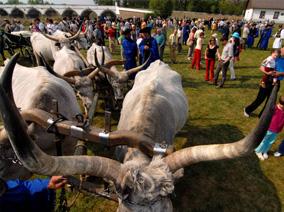
Winner in the Tourism and Local Intangible Heritage category
Hortobagy is not only part of Europe’s Great Plains region, the largest uninterrupted natural grassland in Europe, but also the place of herdsmen who have preserved a very ancient way of life.
The outstanding landscape of Hortobagy, known as 'puszta', is a unique example of the harmonious coexistence of people and nature.
Through the considerate use of the land, both the diversity of species and habitat have been preserved. Traditional Hungarian domestic animals (nonius horse, Hungarian grey cattle, racka sheep, water buffalo, mangalica pig), as well as herdsmen, shepherds and horsemen are a regular part of the landscape.
Herdsmen - and age old way of life
The customs, festivities and gastronomy of Hortobagy herdsmen have endured through the centuries.
200 families still perpetuate the traditional way of life. There is also a famous centre for horse breeding which tells of the 300 years of the Máta stud.
Visitors can discover more about this living heritage through the national herdsmen competition, the Hortobagy international equestrian days, and through the Herdsmen’s Museum.
Protected areas - Hortobagy National Park
The Hortobagy National Park, encompassing 80,000 hectares, is Hungary’s largest protected area.
One of the most amazing sights in the park are its birds – flocks of migrating birds such as geese, cranes and shore birds can be spotted around the park.
A major part of the national park consists of natural habitats, alkaline grasslands and meadows, with marshes enclosed between them as a result of the water’s paths.
Architectural attractions – Hortobagyi Csarda
Hortobagy used to be a commercial crossroads, and today provides many related attractions.
The Hortobagyi Csarda is the most valuable architectural monument of Hungarian catering trade. Dating back to the 17th and 18th centuries, it was rebuilt several times and is now a Folk Baroque style building. The Csarda serves its guests with local dishes made from carefully selected organic ingredients.
The Herdsmen’s Museum was used for storing the carts of the guests staying in the Csarda. Now it provides a comprehensive overview of the history, and of the natural and cultural treasures of Hortobagy, as well as of herdsmen traditions.
The Korszin (circular house) Museum is unique for its demonstrations of traditional craftsmanship. Different handcrafts can be bought here.
Flora and fauna – Hortobagy’s rare breeds
The rare breed park is an open-air exhibition of traditional Hungarian domestic animals, such as the nonius horse, Hungarian grey cattle, water buffalo, racka sheep and the mangalica pig.
The Hortobagy Visitor and Educational Centre exhibition presents the rich flora and fauna of the national park by means of interactive multimedia tools. The centre houses a tourist information office and handcraft workshops.
There are many other interesting activities for tourists like the Hortobagy international workshop for painters, the international workshop for creative art, the exhibition of Hungarian grey cattle breed history or the photo exhibition of the herdsmen’s living heritage.
Fairs and events
The Hortobagy hosts a wide range of popular events, many of which relate to the herdsmen.
There are 'driving-in' and 'driving-out' celebrations which relate to the herdsmens' activities and take place at the end of autumn and the beginning of spring.
- Herdsmen’s Festival – Hortobagy International Equestrian Days: for decades, this festival aims to preserve the noble traditions of Hungarian equestrian culture.
- Hortobagy Bridge Fair: this outstanding event of livestock farming and the biggest animal fair is also a gathering place for craftsmen and professionals of folk culture.
- Festival Of The Cranes: one of the most spectacular phenomena of autumn is the arrival of tens of thousands of cranes in Hortobagy that can be seen every October as they fly above the grasslands to their overnight roosting places.
- Palace Garden Evenings: this one-week event awaits guests wishing to relax and amuse themselves with a wide, colourful variety of programmes. Traditional activities like five o’clock tea, cooking competitions, organ recitals, concerts, theatre performances, exhibitions and sporting events are organised during this series of events.
Other events are held throughout the year like the National Organic Fair, the National Manual Harvesting Competition, the National Cooking Competition of Organic Foods, the Debrecen Turkey Days, the International Festival of Military Bands, and the Debrecen Flower Festival.
More information
- The official website of Hortobagy
- Watch the EDEN video about Hortobagy:
- Long version (3 minutes)
- Short version (1 minute)
- EDEN contact for the Hortobagy: bg
 hortobagyikht [dot] hu (bg[at]hortobagyikht[dot]hu)
hortobagyikht [dot] hu (bg[at]hortobagyikht[dot]hu)
Orseg - 2007 Winner
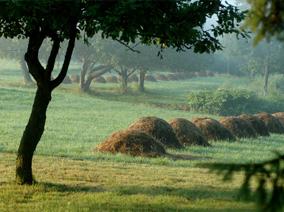
Winner in the Best Emerging European Rural Destination of Excellence category
The Orseg region is located in the western corner of Hungary.
Orseg means 'defence area', as the region originally played a frontier-guarding role at the time of the Hungarian conquest.
Orseg is the only region in Hungary where inhabitants have continuously been living in the same place. Throughout the centuries, Orseg's inhabitants have created its characteristic landscape in harmony with nature.
This unique landscape is characterised by a variety of natural beauties: hills and valleys, deciduous and coniferous woodlands, green hayfields, moors, springs and streams. Besides these features, the unchanged folk traditions and customs, traditional crafts and the products of self-sufficient farming and lifestyle also attract visitors.
What makes Orseg special?
Some examples of unique attractions in the region are:
- Flora: the whole area of the Orseg region is strictly protected, with over a hundred protected species. Guided tours, nature trails and educational centres for natural protection all help visitors to acquire knowledge and a better understanding of the flora and habitat of this region.
- Fauna: The richest butterfly population of Hungary lives in this region.
An internationally protected, rare dragonfly species can also be found here. The occurrence of brook lamprey (Eudontomyzon mariae) is a real curiosity. There is also a substantial population of large wild game: wild pigs, deer and red deer are some examples. Orseg also has several indigenous types of farm animals, e.g. bovine animals (Hungarian Red and White Cattle, Hungarian Grey Cattle), the Murakoz horse, and the Cigája sheep (Ovis ammon f. aries). - Agriculture: Indigenous fruit plants can be visited in the orchard of the Orseg National Park, where one can participate in farm and garden demonstrations.
- Gastronomy: Visitors can taste local specialities of gastronomy (mushroom soup, strudel filled with pumpkin and poppy seed, game dishes, buckwheat porridge, potato dumpling 'dödölle', salads with pumpkin seed oil,) and typical drinks of the region (schnapps with honey, local wines) in the restaurants, pubs and inns. Visitors can also participate in organised pig-killing dinners, harvest festivals and gastronomic competitions (e.g. the competition of pumpkin dishes).
- Architecture: There is a typical settlement type in Orseg. This settlement structure is called 'szeres' and means groups of houses, which were originally inhabited by members of an extended family. The traditional houses and farm buildings are exhibited in an open-air museum in Szalafo. Tourists can also visit Magyarszombatfa where the typical household and lifestyle of a peasant are presented.
- Handcraft: Local pottery products can be bought in the workshops of the craftsmen or in the chandler’s shop at Pityerszer. Tourists can also try to shape their own, self-made ceramic souvenirs.
- Traditions: During their stay in Orseg tourists can participate in horseback archery shows, traditional archery parades and training. There are also cultural programmes introducing the traditional music (performance of a traditional band playing the psaltery) and fairytale traditions (authentic fairy-tale evening) of Orseg.
Experiencing the sites
The protected areas of Orseg National Park assure the conservation of natural, cultural, historical and ethnographic treasures of this beautiful countryside.
Orseg is also an excellent place for those who are passionate about mushroom forays.
In addition to the natural treasures, visitors will find a wide range of cultural treasures, including the typical settlement types of the region, traditional houses, belfries, Romanesque churches and several museums.
Rural accommodation facilities, pubs and restaurants with gastronomic specialties, a bright spectrum of services (e.g. journey on a cart, horseback riding, fishing and hunting, renting a bicycle, hot-air balloon riding, guided tours etc.), as well as the different museums and other exhibition facilities, are some of the elements that Orseg offers tourists.
In addition to these offerings, a Tourist Information Office - Tourinform, uniform signposting. Maps and an adequately marked road network help tourists to find their way throughout their discovery tour in Orseg.
Orseg benefits from being a border region by having good relations with the Slovenian border settlements. Part of this cooperation is the cross-border project called 'Őrállók útja' (Route of Watchers) which includes investments aiming at enlarging tourism, brochures presenting the attractions of the region and the implementation of study-tours.
Development experiences of previous years, including elements of product development and training, are aggregated in the Nature Park Academy Programme.
A strong identity
Orseg's tourism marketing concept is based on the objective to establish, develop and maintain a unique character and identity for the region.
The image of Orseg can be described as the place where you can perfectly enjoy tranquility, fresh air, silence and calm, inspiring you to take a deep breath and relax. The ancient harmony between local people and nature are reflected in the unique landscape features, such as woods, fields, pastures and large forests.
In order to establish and improve Orseg's identity in the region, common actions and training programmes have been implemented in collaboration with the stakeholders of the local tourism sector.
Furthermore, a thorough and systematic inventory of tourist attractions has been made in order to lay the foundations for the positioning of the region and to define the most important elements of its image.
This provides the basis for the content and format of regional brochures as well as for the design of appearance at the different exhibitions.
More information:
- The official website of Orseg
- Watch the EDEN video about Orseg
- Long version (3 minutes)
- Short version (1 minute)
- EDEN contact for Orseg: markusf
 onp [dot] kvvm [dot] hu (markusf[at]onp[dot]kvvm[dot]hu)
onp [dot] kvvm [dot] hu (markusf[at]onp[dot]kvvm[dot]hu)
